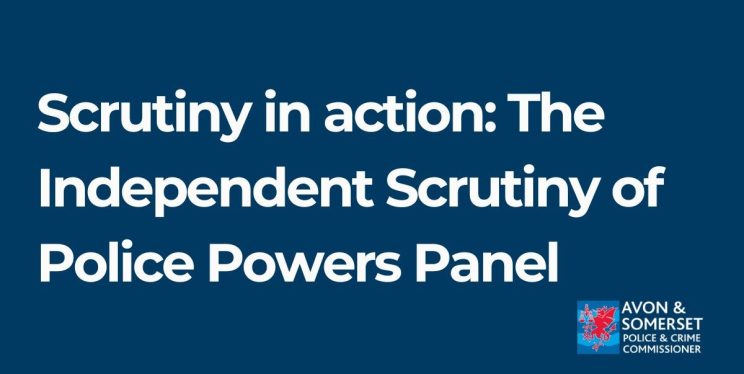Scrutiny in action: The Independent Scrutiny of Police Powers Panel, blog 3 of 3

The Independent Scrutiny of Police Powers (ISOPP) comprises volunteers from diverse backgrounds in the local community who play a pivotal role in monitoring the use of force and stop search by the police. This is the final of a series of three blog posts detailing the panel’s most recent session on 21st March.
The ISOPP Panel convenes quarterly to scrutinise files and footage related to the police’s exercise of their powers. The meeting is attended by the panel members, representatives from Avon and Somerset Police, and representatives from the Office of the Police and Crime Commissioner. After each meeting, the panel produces a comprehensive report detailing their findings. This report is then submitted to the Police and Crime Commissioner for oversight, as well as to the police for a response.
In this meeting, representatives of the Independent Office of Police Conduct (IOPC) came to give a summary of how the IOPC came to the concluding decision regarding the Bedminster bus incident.
The Bedminster bus incident
The Bedminster bus incident refers to an incident on 16th December 2020 when a woman, who was with her child, on a bus in Bedminster was accused of refusing to pay for her bus ticket. The police attended following a call from the bus driver. The incident escalated and resulted in the women being PAVA sprayed (PAVA is an an irritant spray similar to pepper spray), restrained, and arrested. The ISOPP panel reviewed footage of the incident found that the level of force used was inappropriate, with incorrect decisions made during the episode.
Avon and Somerset Police also voluntarily referred the incident to the Independent Office of Police Conduct (IOPC) which investigated and concluded the use of force “was justifiable, proportionate and necessary” but some of the comments by officers did merit reflective practice.
The following panel questions are a sample of some of those put to a representative from the IOPC who was responsible for the decision on this case:
ISOPP Panel member: The IOPC is to increase public trust in what the police do – the fallout in communities from the documentary (‘To Catch a Copper’) is deep. In what sense do you abide by this? How did you get to the point of ‘no case to answer’ I would like to understand the decision making.
IOPC Representative: A case to answer means that there is a breach of standards that justifies a written warning. That is a high threshold. We want to retain people and help them learn…The officers did not engage appropriately. I was the one who suggested reflective practice.
ISOPP Panel member: I’m surprised to hear you say that a written warning is a high level of sanction. I would challenge that.
ISOPP Panel member: I have seen the full video. Seeing all those hands on her. It was disturbing. I don’t think your conclusion was fair, nor does the community.
ISOPP Panel member: Do you have the right cultural awareness training? Who do you check with? This one sent huge shocks, and that one decision made by someone not from that community is concerning.
ISOPP Panel member: A written warning is not a high level of discipline – is this the reasonable action of a reasonable employer.
IOPC Representative: There was a shift in the system in 2020 which moved the bar up for actions as there were people under investigation but who had no likelihood of an outcome.
Next steps
This is a part of a longer conversation in which the ‘no case’ finding and the use of reflective practice were comprehensively challenged and questioned by the panel. The IOPC representative concluded that they stand by their findings.
The next step is that the ISOPP and the IOPC continue to discuss their respective positions on this case and this will remain a focus for the panel.
